What will Ruben Amorim bring to Manchester United?
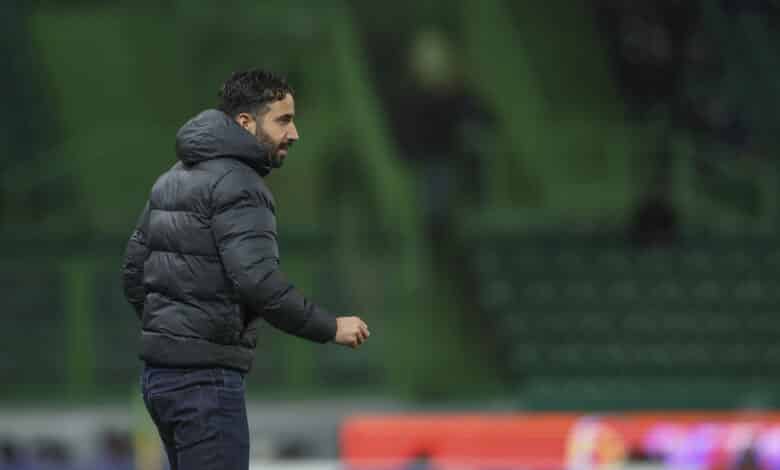
The Erik ten Hag era is over at Manchester United. The Dutch manager hung on, rescuing his job from the jaws of defeat many times. But he couldn’t do it again after a 2-1 defeat in London to West Ham. In came Ruud van Nistelrooy, his former assistant, to steady the ship for a few games. It does now seem that the waters are more tame as Ruud won three of his four games and remained undefeated, but the Dutchman’s time at Carrington is also up now that Ruben Amorim has arrived.
Formerly of Sporting Lisbon, Amorim has made a massive name for himself in the coaching world. Still just 39, he has transformed Sporting Lisbon’s fortunes, and when United saw an opportunity for him, it was too good to pass up.
Read on to find out what Amorim will bring to Manchester United.
It's official! Rúben Amorim is the new Manchester United manager. The Portuguese coach has signed a contract until June 2027 with an option for an additional year. ?? pic.twitter.com/B0CRioMQGB
— 365Scores (@365Scores) November 1, 2024
The Ruben Amorim guide
Amorim’s Background
Ruben Amorim’s journey to becoming Manchester United’s manager has been nothing short of remarkable, blending ambition, tactical evolution, and meteoric success. After a solid playing career, Amorim wasted no time transitioning to coaching, quickly earning his licence and attending courses in psychomotor education to better understand player movement and mental conditioning.
His early experience included a stint with José Mourinho at Manchester United, where he observed firsthand the demands of a top-tier club environment. He began his managerial career with Casa Pia in Portugal’s third division, where a rough start nearly ended his ambitions. However, a last-ditch switch to a back-three formation proved transformative, sparking a long unbeaten run and unveiling the tactical flexibility that would become his hallmark.
Amorim’s breakthrough came with Braga, where he moved rapidly from the B team to the senior side in 2019. There, he earned praise for his bold, pressing style and knack for adapting to game dynamics. Within months, he had led Braga to a League Cup win over Porto and secured their first away victory over Benfica in 65 years. His success at Braga didn’t go unnoticed, and in 2020, Sporting Lisbon secured his services for a reported €10 million, making him one of the most expensive managers ever.
At Sporting, Amorim’s methods took full flight. His focus on youth development, high pressing, and fluid formations brought Sporting their first league title in nearly two decades, setting records and renewing pride at the club. With his reputation cemented by back-to-back successes and an impressive Champions League run, Amorim’s name was inevitably linked to bigger roles.
When United parted ways with Erik ten Hag, they saw in Amorim a manager who could build a cohesive, dynamic team—a style that resonated with the club’s ambitions. Now, with his tactical prowess and unyielding drive, he is set to bring fresh momentum to Old Trafford.
After 18 years, Sporting Lisbon are finally Champions of Portugal again! It is their 19th league title. #Sporting #365Scores #SportingLisbon #SportingCP #Amorim #Coates #Cabral #Tabata pic.twitter.com/dsAL8xxJOA
— 365Scores (@365Scores) May 11, 2021
How are his Sporting Lisbon doing this season?
Sporting Lisbon are flying high this season, kicking off their campaign with a stunning eleven-game winning streak in the Primeira Liga. This blistering start has catapulted them to the top of the table, and fans are daring to dream of a historic back-to-back championship—a feat they haven’t pulled off since the 1950s. Amorim’s squad looks nearly unstoppable, boasting a solid defense that has conceded only five league goals.
But it’s their electrifying attack, led by Swedish striker Viktor Gyökeres, that has turned heads. Since arriving in 2023, Gyökeres has racked up an astonishing 45 goals in 44 league matches, positioning himself as one of Europe’s most lethal strikers. His energy and clinical finishing have been pivotal, turning Sporting into a goal-scoring machine that just doesn’t stop.
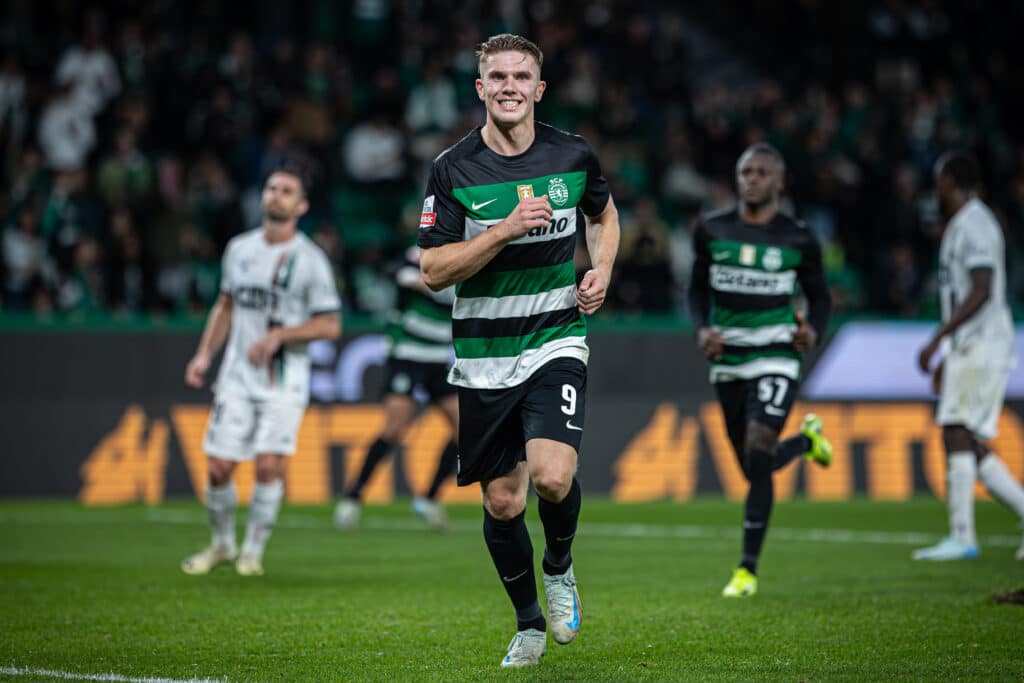
Amorim’s men even made a statement in Europe, notching a memorable 4-1 win over Manchester City in the Champions League—an upset few saw coming. Their domestic dominance is no fluke, either, with Sporting consistently outplaying opponents through well-drilled passing sequences and rapid transitions.
Amorim’s approach has delivered Sporting the kind of consistency they lacked for years, and it’s safe to say that his meticulous planning is reaping major rewards. United will be hoping some of that magic can rub off on Rasmus Højlund, their own Scandinavian target man, who could certainly use a few pointers from Amorim on how to tap into Gyökeres’ level of impact.
How does he like to play?
Amorim’s playbook revolves around a disciplined, possession-focused 3-4-3 (often appearing as a 3-4-2-1), and he rarely strays from this structure. Amorim’s philosophy is drilled down to the smallest detail on the training ground, with each player expected to maintain tactical discipline and operate within a well-coordinated, cohesive unit.
The system has clear roles: the three center-backs and goalkeeper, comfortable on the ball, are tasked with drawing the opposition high, creating open space in midfield where playmakers can work. His central midfielders are typically balanced and cautious, positioned to control the game rather than constantly surging forward.
One of the pair is usually given the green light to make late runs into the box, keeping opponents guessing. On the flanks, Amorim has occasionally deployed pure wingers as wing-backs, showing a willingness to sacrifice defensive rigidity for extra attacking punch. The rapid rise of 17-year-old Geovany Quenda in this role exemplifies Amorim’s bold choices in shaping the team’s attack.
Up top, he employs what might be called a “double No. 10” setup, with two creative players tucked behind the striker. These attackers are tasked with interlinking with the wing-backs and creating space through constant movement. Critics may highlight a heavy reliance on Gyökeres to score, yet Amorim’s forward line remains productive, with players like Pedro Gonçalves, Francisco Trincão, and Pablo Sarabia regularly chipping in with goals of their own.
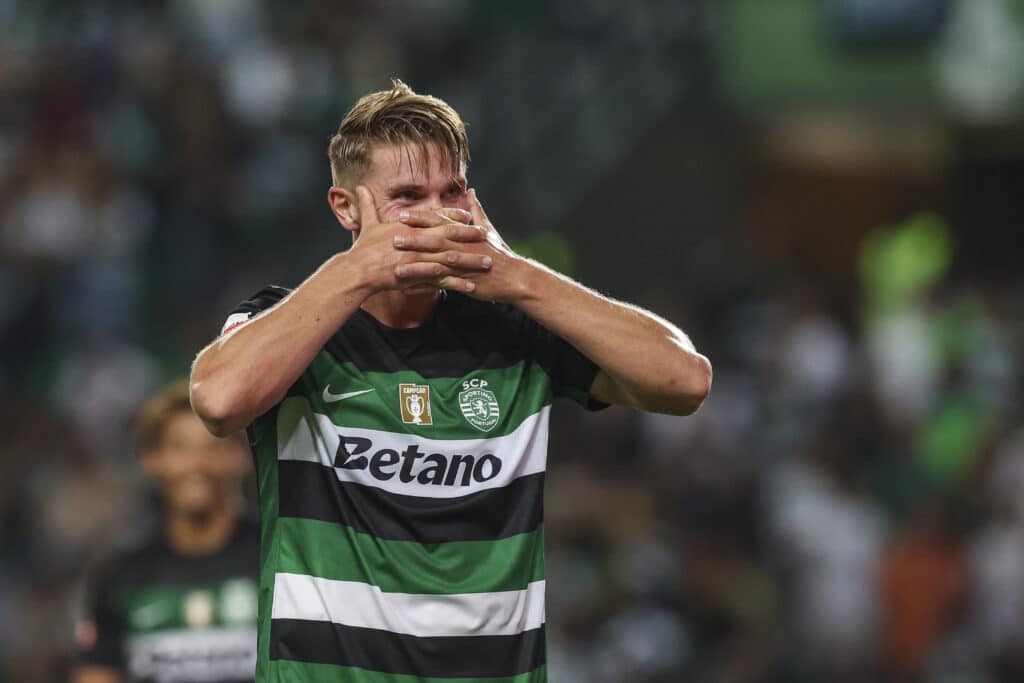
Defensively, Sporting are fierce off the ball, adopting a high-energy pressing approach that can morph depending on the opposition’s setup. When they lose possession, the team instantly falls into organized pressing patterns, switching from attack to defense in the blink of an eye. In situations where more caution is called for, Sporting drops into a compact 5-2-3 low block. This setup positions five players to spring forward the moment they regain the ball, enabling quick, efficient counter-attacks.
How may United line up against Ipswich in two weeks?
For Amorim’s debut match against Ipswich, this lineup blends tactical familiarity with some bold changes to maximize both experience and adaptability, traits that define his preferred 3-4-3 setup. Let’s break down why each position has been carefully selected.
Goalkeeper: Andre Onana
Andre Onana’s ability to play out from the back aligns seamlessly with Amorim’s philosophy. His calmness under pressure and comfort with the ball at his feet are crucial for initiating attacks, as Amorim’s style demands that goalkeepers not only distribute accurately but also read the game well to support the center-backs.
Back Three: Lisandro Martínez, Matthijs de Ligt, Leny Yoro
The back three of Martínez, De Ligt, and Yoro is designed for flexibility and ball progression. Martínez brings an aggressive, front-footed approach, stepping forward to disrupt opponents and play out quickly. De Ligt adds height, defensive solidity, and passing range, which will allow him to start attacks from deeper areas and maintain a composed presence. Yoro, still young, is coming back from an injury and will likely feature in Amorim’s new-look United side. He’s been touted as a generational talent.
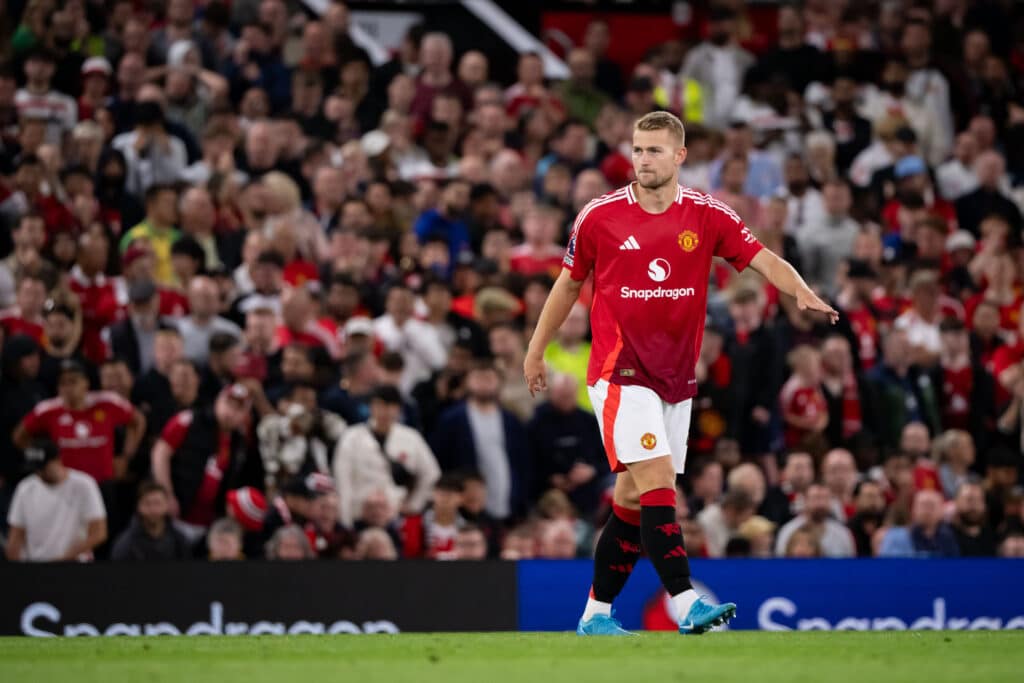
Wingbacks: Diogo Dalot, Noussair Mazraoui
Diogo Dalot and Noussair Mazraoui provide the high-energy wingback play Amorim favours. Dalot’s versatility and stamina make him a natural fit on the right, where he can push high to support attacks while tracking back defensively. Mazraoui adds technical ability and familiarity with high-press systems, allowing him to create width on the left and work seamlessly with Martínez and De Ligt. Both wingbacks will be integral to stretching Ipswich’s defense and creating space for United’s attackers to exploit.
Midfield Pivot: Casemiro, Manuel Ugarte
Casemiro and Manuel Ugarte form a balanced yet formidable midfield pivot. Casemiro’s defensive prowess and positional discipline give the back three additional security, while his passing range can kickstart quick transitions. Amorim knows Ugarte well from Sporting Lisbon, where he relied on Ugarte’s ability to press intelligently and make incisive passes. Ugarte’s energy complements Casemiro’s experience, and his familiarity with Amorim’s system will help bring stability and cohesion in midfield.
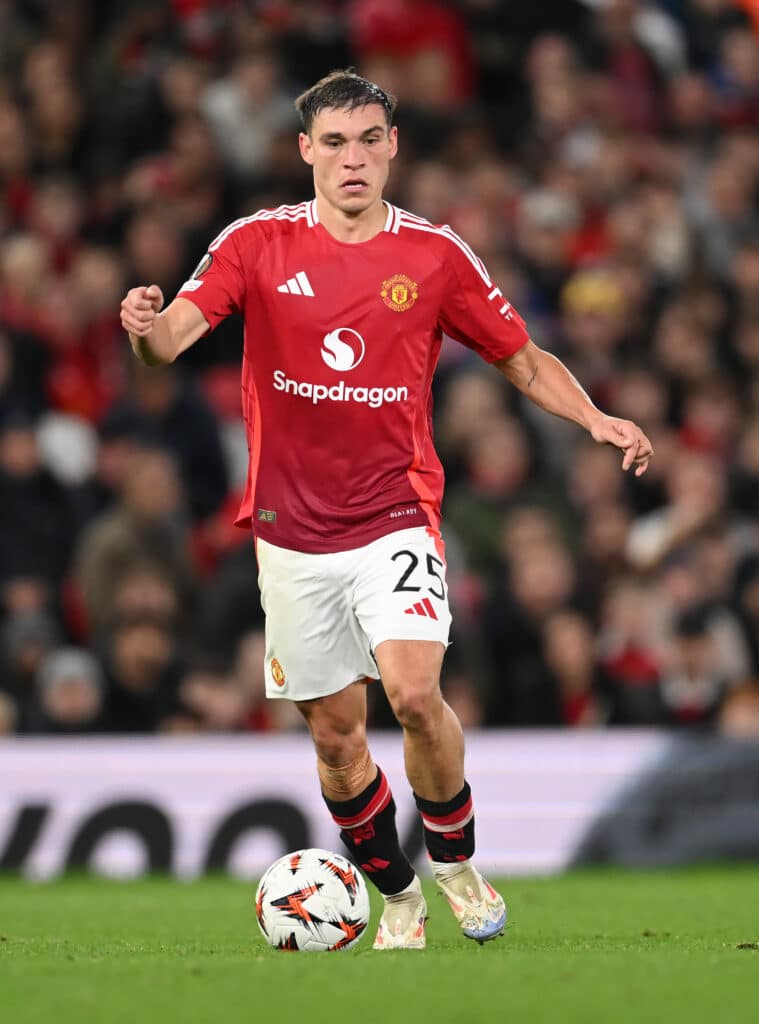
Front Three: Rasmus Højlund, Amad Diallo, Bruno Fernandes
Up front, Amorim goes with a mobile, skillful trio in Rasmus Højlund, Amad Diallo, and Bruno Fernandes, designed to create movement and exploit Ipswich’s back line. Højlund, the target man, takes on a role similar to Sporting’s Viktor Gyökeres—staying central and working off the service from wingbacks and midfield. His athleticism and energy will keep defenders on their toes, allowing him to play as both finisher and link-up forward.

Amad Diallo, cutting in from wide positions, offers pace and creativity, keeping defenders occupied with his dribbling and ability to unlock tight spaces. His natural flair aligns with Amorim’s tendency to employ a “double No. 10” setup, where he can drift infield and combine with Højlund or Fernandes. Fernandes, as the creative playmaker, completes the front three, taking on the primary creative responsibilities. His ability to make late runs into the box and combine with the wingbacks will be essential for creating overloads on the flanks and stretching Ipswich’s defensive shape.
Summary
Amorim’s starting XI against Ipswich blends tactical discipline with high-pressing energy and an emphasis on ball-playing defenders and dynamic midfielders. This lineup capitalizes on his 3-4-3 blueprint, where his trusted pivot of Casemiro and Ugarte provides security, while the front three, led by Højlund, injects creativity and movement. It’s a setup that embraces Amorim’s philosophy of controlled possession, positional discipline, and quick transitions—a perfect introduction to the tactical direction he intends to bring to United.
By Nicky Helfgott – NickyHelfgott1 on X (Twitter)
Keep up with all the latest football news and Premier League news on 365Scores!



